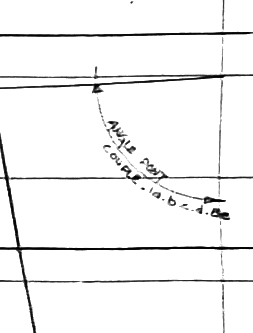- Construction details for the Moth-Pop can be found in Part 2 of this series.
- A computer rendering of the Moth-Pop can be found in Part 3 of this series.
Benoit Duflos was the designer who, in the 1960's, introduced the narrow waterline, very V'eed Moth design that would prove to be the fastest Moth design of that decade, the Duflos ruled the roost until the class merged with the Antipodean scow fleet and adopted wings. Until George A, the USA Classic Moth plan librarian handed me these plans, I hadn't realized that Benoit also designed a more stable design, specifically for home-builders. Benoit's design, the Moth-Pop (no idea where he came up with the name) is a flat-bottom design, in the tradition of French dinghy designs, Staempfli's Sharpie 9m2 and, Herbulot's very popular Vaurien dinghy. It is designed to be built upside down on a flat deck using three bulkheads, a small bow transom and the normal transom. Starting at the front of the cockpit the flat bottom transitions into a arc'd V toward the transom to reduce wetted surface. There are probably a couple of Moth-Pop's still sailing in France but I have yet to come across a photo of one
I have taken a couple of JPEG's of the plans which can be viewed or downloaded. Use the pop-out icon on the top-right corner to put the image into another tab on your browser. From there you can print or download the file.
In this first side view image we can see that:
- Stations b, c, d and bow transom (1a) and regular transom (8e) are the bulkheads that Moth-Pop is built around and stay with the hull after completion.
- The bulkheads are set up on the flat deck with a backwards angle (angled towards the transom) as shown by the arc Benoit has drawn at section 1a. This is to keep the bulkheads perpendicular to the design waterline.
- All dimensions are in cm. (mm are indicated as a superscript to the cm dimension) unless it is a single digit, which is mm.
Below is an iso view of the underside of the Moth-Pop deck. Benoit has the builder plot the sheer and cockpit dimensions on the flat piece of plywood deck before placing the bulkheads upside down.
The section plans. Note how the bottom becomes an arc as it transitions toward the transom. Benoit has written the metric dimensions on the plans which can be viewed when zoomed in.
A closeup of the angle of bulkheads when placed on the flat deck.



2 comments:
This looks like a very easy set up with the flat deck. But once the frames were in place and rigidity ensured I think I would put the whole kit on top of a few saw horses to make it a bit easier to work on.
Alden,
Agreed. It is always better to work at a comfortable height. If I was to build Moth-Pop I would probably build the deck as a foam-core glass composite so it already had some stiffness before attaching the bulkheads. The rest of the build would be in wood as specified. I would also probably add at least one set of fore-aft stringers per side to stiffen up the flat 4mm ply bottom. For an experienced builder a set of plans like this is always just a starting point and worthy of some experimentation.
Post a Comment